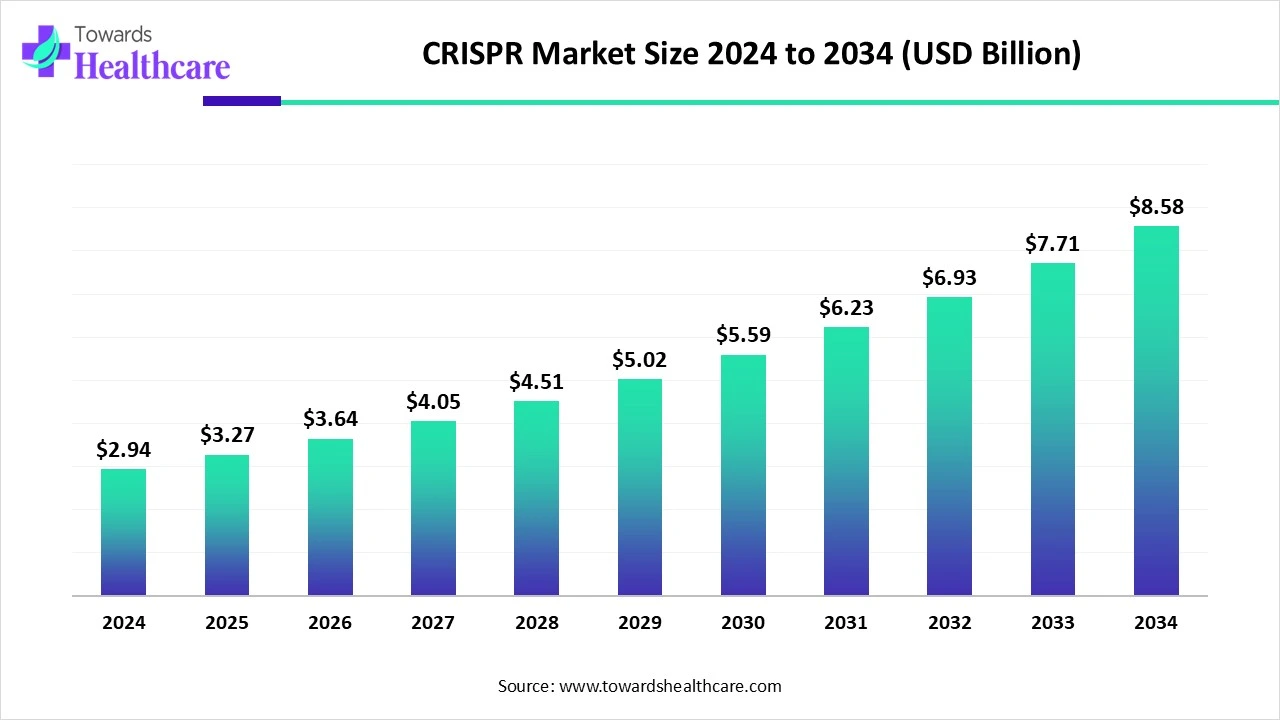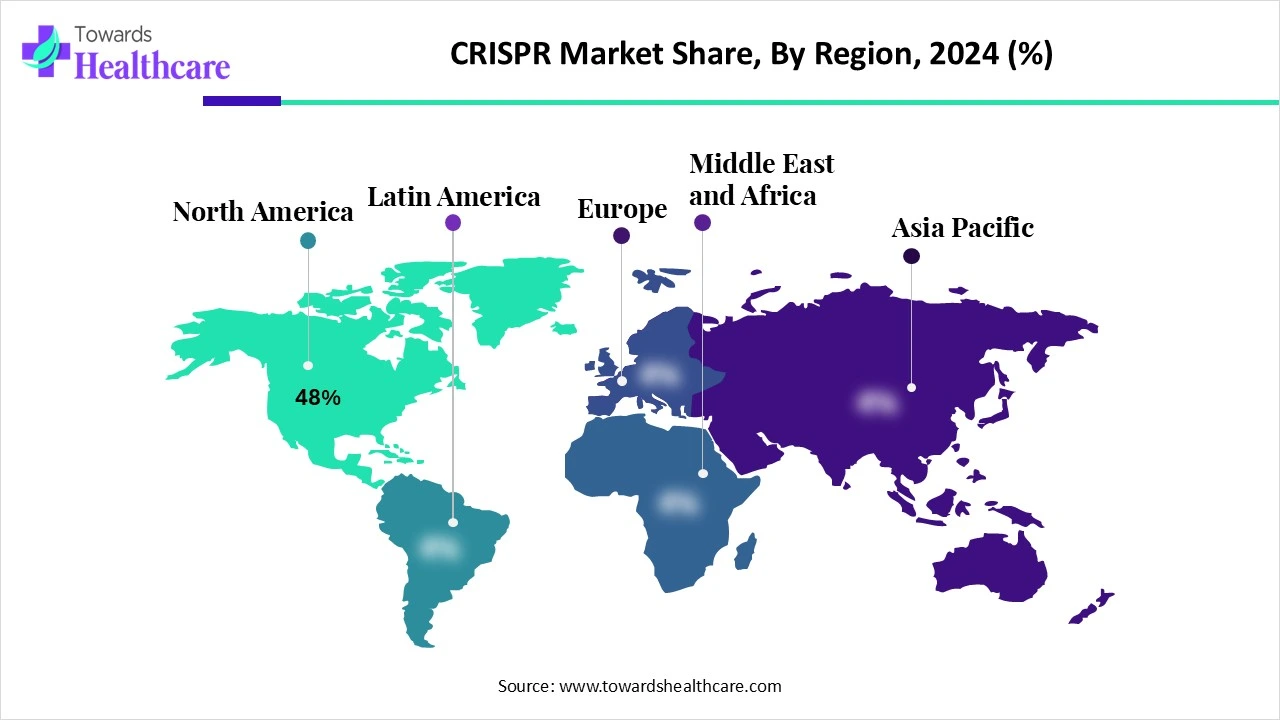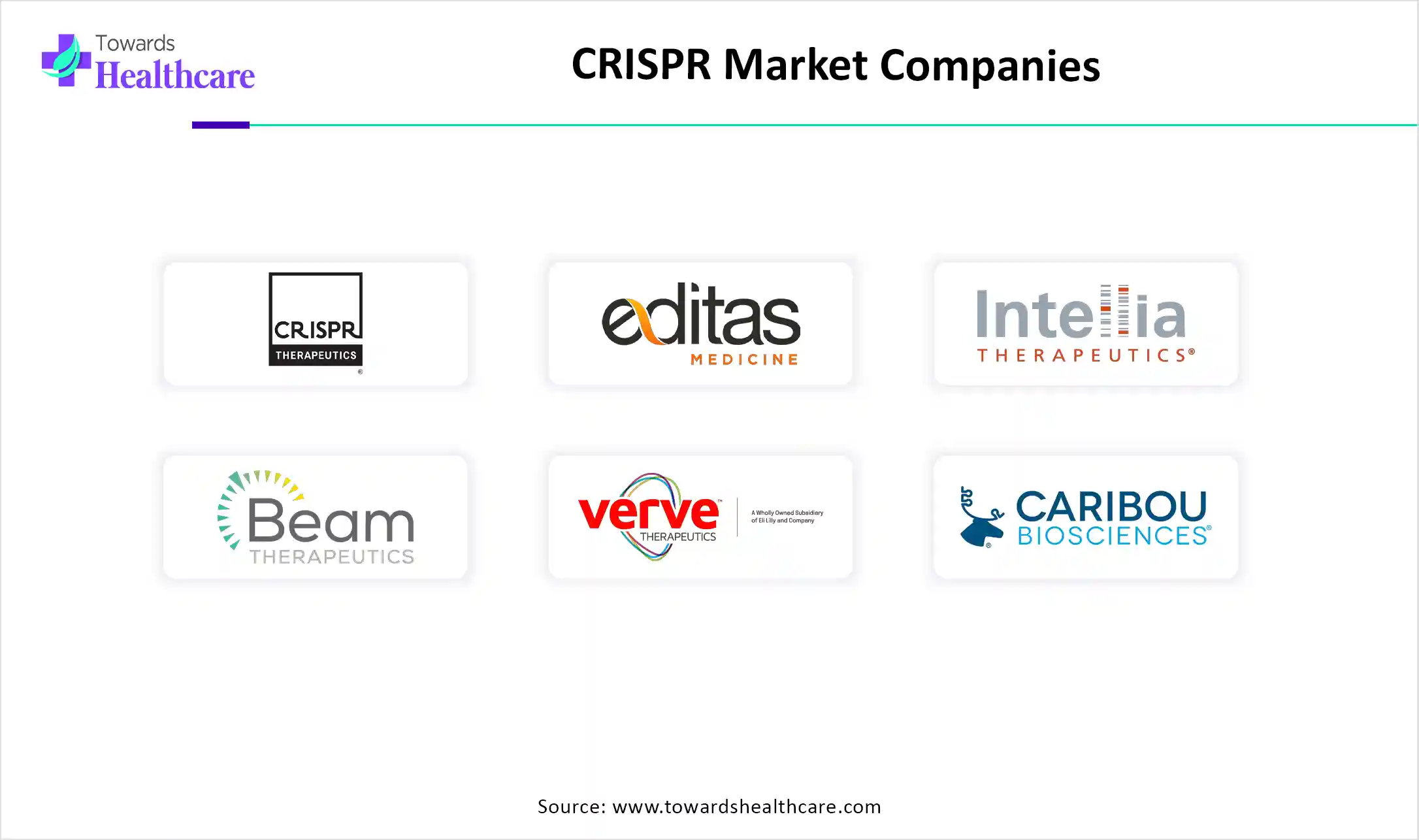December 2025

The global CRISPR market size began at US$ 2.94 billion in 2024 and is forecast to rise to US$ 3.27 billion by 2025. By the end of 2034, it is expected to surpass US$ 8.58 billion, growing steadily at a CAGR of 11.24%.

The CRISPR market is experiencing strong growth, driven by its expanding applications in gene therapy, agriculture, and diagnostics. With rising investments in biotechnology and increasing demand for precision medicine, CRISPR is becoming a key tool for treating genetic disorders and cancer. North America leads the market, supported by advanced research infrastructure and favorable regulatory support. Ongoing innovations and strategic collaborations are expected to further boost market expansion over the coming years, making CRISPR a transformative technology.
| Metric | Details |
| Market Size in 2025 | USD 3.27 Billion |
| Projected Market Size in 2034 | USD 8.58 Billion |
| CAGR (2025 - 2034) | 11.24% |
| Leading Region | North America Share 48% |
| Market Segmentation | By Product Type, By Application, By End User, By Therapeutic Application (for Clinical CRISPR Use), By Delivery Method, By Region |
| Top Key Players | CRISPR Therapeutics AG, Editas Medicine, Inc., Intellia Therapeutics, Inc., Beam Therapeutics, Inc., Verve Therapeutics, Inc., Caribou Biosciences, Inc., Synthego Corporation, Horizon Discovery, ToolGen, Inc., Inscripta, Inc. Agilent Technologies, Inc., Thermo Fisher Scientific, Inc., Sigma-Aldrich, Origene Technologies, Inc., AstraZeneca, Locus Biosciences, Mammoth Biosciences, Sherlock Biosciences, Pairwise, SNIPR Biome |
The mencompasses technologies, products, and services related to CRISPR (Clustered Regularly Interspaced Short Palindromic Repeats), a revolutionary gene-editing tool that enables precise modification of DNA in living organisms. CRISPR systems, especially CRISPR-Cas9, Cas12, and Cas13, are widely applied across therapeutic development, agriculture, diagnostics, functional genomics, and drug discovery. The market is fueled by increasing adoption in human gene therapy, expanding genetic screening and disease modeling, and rising investments in next-gen CRISPR platforms, including base editing and prime editing. The CRISPR market is driven by rising demand for gene-editing therapies, advancements in biotechnology, growing investment in R&D, and expanding applications in agriculture, diagnostics, and drug discovery. Supportive regulatory frameworks also contribute to market growth.
AI is significantly impacting the CRISPR market by enhancing the accuracy, speed, and efficiency of gene-editing processes. It helps identify optimal target sites, predict off-target effects, and streamline the design of guide RNAs, reducing trial-and-error in lab settings. AI-driven data analysis also accelerates discovery in drug development and functional genomics. By integrating AI, researchers can develop safer and more effective CRISPR-based therapies, ultimately reducing costs and time-to-market in clinical and agricultural applications.
Increasing Demand for Gene-Editing Therapies
Growing interest in gene-editing therapies is driving the CRISPR market as researchers and pharmaceutical companies explore its potential to address the root causes of inherited and complex diseases. Unlike conventional treatments that manage symptoms, CRISPR enables direct correction of faulty genes, offering more durable outcomes. As clinical successes increase and regulatory support improves, the confidence in CRISPR’s therapeutic potential rises, encouraging further development and accelerating its integration into advanced healthcare solutions.
For Instance,
Ethical and Regulatory Concerns
Ethical and regulatory challenges limit CRISPR’s growth by creating uncertainty around its use, especially in human gene editing. Concerns about long-term safety, potential misuse, and altering the human germline have prompted cautious regulatory approaches worldwide. These issues often delay approvals, restrict certain applications, and raise public hesitations. As debates continue over the responsible use of gene-editing tools, researchers and companies must navigate complex ethical frameworks, slowing broader acceptance and commercial progress in the CRISPR market.
Development of New Vaccines and Treatment for Genetic Diseases
Advancements in CRISPR technology offer a promising future in developing innovative treatments and vaccines for genetic disorders. Its precision allows scientists to modify genes responsible for inherited conditions, offering the potential for lasting cures. As research progresses, CRISPR can help design targeted therapies for rare and previously untreatable diseases. This creates new opportunities for biotechnology firms to lead in personalized medicine, transforming the landscape of genetic healthcare and improving patient outcomes on a broader scale.
For Instance,
In 2024, the CRISPR products segment led the market owing to the widespread use in research and biotech industries. The demand surged as scientists increasingly relied on these products for faster and more accurate genome modification. Additionally, their easy availability, improved efficiency, and role in enabling complex genetic experiments positioned them as essential tools in advancing gene therapy and precision medicine applications.
The CRISPR services segment is projected to grow at the fastest CAGR due to the rising demand for outsourced gene-editing solutions in academic and pharmaceutical research. Many institutions prefer tailored services like genome editing, screening, and custom projects to save time and reduce infrastructure costs. Additionally, increasing adoption of CRISPR by smaller biotech firms, which often lack in-house capabilities, is fueling the need for specialized service providers offering precision, scalability, and expertise in complex gene-editing projects.
In 2024, the biomedical research & functional genomics segment held the largest shares of the CRISPR market as scientists increasingly relied on genome-editing tools for uncovering genetic pathways and advancing disease biology studies. This segment benefited from CRISPR's role in accelerating gene function analysis, enabling efficient identification of biomarkers, and supporting innovations in therapeutic discovery. The rising demand for advanced research in rare and chronic diseases has further strengthened the leadership in the market.
The therapeutics development segment is projected to grow rapidly in the CRISPR market due to increasing clinical trials and approvals of gene-editing therapies targeting genetic disorders, cancer, and rare diseases. Advancements in precision medicine and growing investments in biotechnology are accelerating CRISPR’s application in creating targeted, efficient, and potentially curative treatments, driving its faster adoption.
The rapid growth of the ex vivo and in vivo gene therapy sub-segment is driven by advances in delivery technologies, improved safety profiles, and greater investment in precision medicine. These approaches offer promising potential to correct genetic mutations at the source, attracting attention for their effectiveness in treating complex disorders like cancer, rare diseases, and inherited conditions.
In 2024, the pharmaceutical & biotechnology companies segment dominated the market, driven by its advanced infrastructure, strong R&D capabilities, and focus on innovative treatment approaches. These companies are leveraging CRISPR tools to streamline drug development, target complex diseases, and improve therapeutic accuracy. Their proactive adoption of emerging gene-editing technologies and high-volume clinical trials has significantly boosted their market presence and made them primary users of CRISPR solutions across multiple therapeutic areas.
The agriculture & food technology firms segment is poised to grow at the fastest CAGR in the CRISPR market due to its transformative role in crop improvement and food sustainability. CRISPR enables precise genetic modification to boost crop resistance, shelf life, and nutritional value. With growing concerns over food security and climate change, these firms are increasingly investing in CRISPR to meet global demands for efficient and resilient food production systems, propelling the rapid expansion.
In 2024, the blood disorders segment emerged as the top contributor to revenue in clinical CRISPR applications, driven by the rising adoption of advanced gene-editing therapies for conditions like sickle cell disease and beta-thalassemia. Groundbreaking approvals of CRISPR-based treatments allowed for durable correction of genetic mutations, reducing the need for lifelong therapies. Strong clinical success rates and growing patient acceptance significantly boosted market growth.
The infectious diseases segment is witnessing rapid growth in the CRISPR market as researchers explore its potential in combating resistant pathogens and emerging viruses. CRISPR’s ability to precisely disrupt viral genomes or enhance immune responses is driving innovations. With growing concerns around global health threats, governments and biotech firms are investing heavily in CRISPR-based tools to develop fast, targeted diagnostics, which is fueling the market expansion during the forecast period.
In 2024, the ex vivo segment dominated the CRISPR market by capturing the largest revenue share. This approach allows cells to be precisely edited outside the body before reinfusion, enabling rigorous quality control and minimizing off-target effects. It has become the preferred technique for treating critical and cancerous conditions, where consistent editing accuracy is critical. The growing use of ex vivo methods in clinical trials and cell therapies further cemented its regulatory and commercial dominance.
The in vivo segment is projected to grow at the fastest CAGR in the CRISPR market due to its ability to directly edit genes within the body, making it ideal for treating diseases in hard-to-reach tissues like the brain or heart. Advances in delivery vectors and safer gene-editing tools are enabling more precise and non-invasive treatments, expanding the therapeutic scope, and reducing the complexity associated with ex vivo methods.

North America dominated the market share 48% in 2024 due to its strong biotechnology infrastructure, significant government and private funding, and presence of key market players. The region benefits from advanced research facilities, a high concentration of clinical trials, and supportive regulatory frameworks. Additionally, early adoption of innovative gene-editing technologies and growing investments in personalized medicine and genomic research have further driven demand, solidifying North America's leading position in the global CRISPR market.
The U.S. market is witnessing strong growth driven by increasing investment in gene-editing R&D, favorable regulatory support, and rising demand for therapies targeting genetic disorders. Landmark approvals like Casgevy for sickle cell disease have validated CRISPR’s therapeutic promise. Additionally, a well-established biotech ecosystem, collaborations between universities and industry, and expanding applications in precision medicine and agricultural biotech are fueling widespread adoption throughout the country.
The Canadian market is witnessing significant growth due to increasing investments in biotechnology research, strong government support, and advancements in gene-editing technologies. Collaborations between research institutions and biotech companies are driving innovation, particularly in therapeutic and agricultural applications. A favorable regulatory environment and rising demand for precision medicine are further boosting the adoption of CRISPR across various sectors, making Canada a key player in this evolving field.
The Canadian market is witnessing significant growth due to increasing investments in biotechnology research, strong government support, and advancements in gene-editing technologies. Collaborations between research institutions and biotech companies are driving innovation, particularly in therapeutic and agricultural applications. A favorable regulatory environment and rising demand for precision medicine are further boosting the adoption of CRISPR across various sectors, making Canada a key player in this evolving field.
China’s market is growing rapidly due to strong government backing, fast-tracked regulatory approval of gene-editing therapies, and increased public and private R&D investment. Domestic biotech firms and academic institutions are heavily involved in both agricultural and clinical CRISPR innovations, supported by policy initiatives that encourage commercialization. With large patient populations, rising incidence of genetic disorders, and expanding infrastructure, China is rapidly becoming a regional leader in CRISPR technology.
India's market is witnessing steady growth due to advancements in gene-editing technologies and rising interest in personalized medicine. Increasing investments in biotech startups, academic research collaborations, and government initiatives to support genomic innovation are boosting development. Additionally, CRISPR’s application in agriculture to improve crop resilience and productivity is gaining momentum, making it a valuable tool across sectors and encouraging broader adoption in the country’s scientific and healthcare ecosystems.
Europe’s market is advancing through strong collaboration between universities, research institutions, and biotech firms, particularly in countries like Germany, the UK, and France. The region benefits from solid government funding, well-established genomics infrastructure, and adaptive regulatory pathways supporting gene-editing research. Europe is leveraging CRISPR in areas such as agriculture, precision medicine, and diagnostics, while reinforcing ethical oversight and sustainability frameworks to drive responsible innovation and market expansion.
The UK’s market is growing rapidly due to cutting-edge academic research, strong government and private investment, and regulatory frameworks that support gene-editing innovation. UK-based biotech firms are leading the way in both therapeutic and agricultural applications, while high-profile clinical trials (such as those backed by the NHS and research councils) are advancing real-world adoption. Active collaboration between industry, academia, and regulators is positioning the UK as a hub for CRISPR development.
Germany’s market is expanding due to its robust biotech ecosystem, significant R&D investment, and leadership in precision medicine and genome editing innovation. Key institutions like Max Planck and Bayer are driving the development of CRISPR/Cas applications in therapeutics and functional genomics. A substantial prevalence of chronic diseases is motivating research into gene therapies. Additionally, Germany’s strong academic-industry collaborations and supportive infrastructure underpin sustained growth and regional market leadership.

In October 2024, ERS Genomics and the Université de Montréal (UdeM) entered into a non-exclusive CRISPR/Cas9 licensing agreement, giving UdeM access to ERS’s CRISPR/Cas9 patent portfolio. This collaboration supports the establishment of two new CRISPR screening platforms at UdeM’s Institute for Research in Immunology and Cancer. Dr. Lynda Adam, Director of Technology Transfer at UdeM, stated that this license enables the launch of genome-wide CRISPR services and fosters collaborative research projects using the technology under defined terms.
By Product Type
By Application
By End User
By Therapeutic Application (for Clinical CRISPR Use)
By Delivery Method
By Region
December 2025
November 2025
November 2025
November 2025